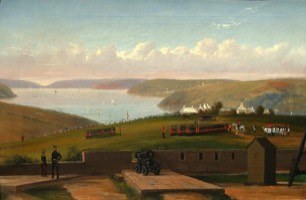The Royal Monmouthshire Royal Engineers (Militia)
-
From Militia to Engineers
The name of the Regiment has changed many times. It became “Royal” in 1804 - as the Monmouth and Brecon Militia. Later it separated from Brecon, and in 1852 was styled Militia Light Infantry.
But throughout the 19th century the importance of the militia system declined as the threat of invasion receded, the aristocracy lost power to municipalities, and new police forces emerged to control civil disorder.
The Crimean War promised excitement, and the officers of the Regiment pledged huge funds to join the campaign. But the militia were not allowed overseas and this regiment was merely embodied for garrison duties at Pembroke Dock. However many men joined other regiments to see action. Colonel Vaughan, an energetic officer who served with the Regiment for forty years, made his own way to the Crimea - and was stirred by the squalor and chaos there into writing an influential booklet urging reforms within the Army.
In 1877, still seeking a more active role, the Regiment accepted an invitation, under the Cardwell Reforms, to transfer to a Special Reserve section of the rapidly developing Royal Engineers - and with a chance to serve overseas.
But throughout the 19th century the importance of the militia system declined as the threat of invasion receded, the aristocracy lost power to municipalities, and new police forces emerged to control civil disorder.
The Crimean War promised excitement, and the officers of the Regiment pledged huge funds to join the campaign. But the militia were not allowed overseas and this regiment was merely embodied for garrison duties at Pembroke Dock. However many men joined other regiments to see action. Colonel Vaughan, an energetic officer who served with the Regiment for forty years, made his own way to the Crimea - and was stirred by the squalor and chaos there into writing an influential booklet urging reforms within the Army.
In 1877, still seeking a more active role, the Regiment accepted an invitation, under the Cardwell Reforms, to transfer to a Special Reserve section of the rapidly developing Royal Engineers - and with a chance to serve overseas.
Training was now overseen by the Royal Engineer Depot at Chatham, and the physical standard for recruits was raised.

A painting of the Royal Monmouthshire Light Infantry at Pembroke Dock in 1855
The Regiment was embodied for the Boer War and sent three companies to South Africa to carry out building, bridging and railway work. Railway transport had become an important role, and after the war a short section of track, with a locomotive, was added to the training equipment in Monmouth.
The Regiment was embodied for the Boer War and sent three companies to South Africa to carry out building, bridging and railway work. Railway transport had become an important role, and after the war a short section of track, with a locomotive, was added to the training equipment in Monmouth.

